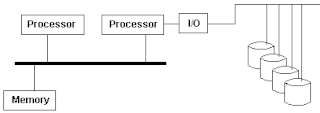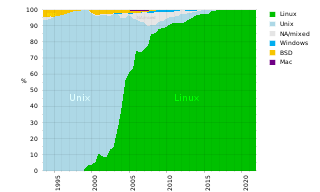A disk operating system (DOS) is a computer operating system that resides on and can use a disk storage device, such as a floppy disk, hard disk drive, or optical disc. A disk operating system provides a file system for organizing, reading, and writing files on the storage disk, and a means for loading and running programs stored on that disk. Strictly speaking, this definition does not include any other functionality, so it does not apply to more complex OSes, such as Microsoft Windows, and is more appropriately used only for older generations of operating systems.

In computing, time-sharing is the concurrent sharing of a computing resource among many tasks or users by giving each task or user a small slice of processing time. This quick switch between tasks or users gives the illusion of simultaneous execution. It enables multi-tasking by a single user or enables multiple-user sessions.

Computer operating systems (OSes) provide a set of functions needed and used by most application programs on a computer, and the links needed to control and synchronize computer hardware. On the first computers, with no operating system, every program needed the full hardware specification to run correctly and perform standard tasks, and its own drivers for peripheral devices like printers and punched paper card readers. The growing complexity of hardware and application programs eventually made operating systems a necessity for everyday use.
Control Data Corporation (CDC) was a mainframe and supercomputer company that in the 1960s was one of the nine major U.S. computer companies, which group included IBM, the Burroughs Corporation, and the Digital Equipment Corporation (DEC), the NCR Corporation (NCR), General Electric, and Honeywell, RCA and UNIVAC. For most of the 1960s, the strength of CDC was the work of the electrical engineer Seymour Cray who developed a series of fast computers, then considered the fastest computing machines in the world; in the 1970s, Cray left the Control Data Corporation and founded Cray Research (CRI) to design and make supercomputers. In 1988, after much financial loss, the Control Data Corporation began withdrawing from making computers and sold the affiliated companies of CDC; in 1992, Cray established Control Data Systems, Inc. The remaining affiliate companies of CDC currently do business as the software company Dayforce.

The CDC 6600 was the flagship of the 6000 series of mainframe computer systems manufactured by Control Data Corporation. Generally considered to be the first successful supercomputer, it outperformed the industry's prior recordholder, the IBM 7030 Stretch, by a factor of three. With performance of up to three megaFLOPS, the CDC 6600 was the world's fastest computer from 1964 to 1969, when it relinquished that status to its successor, the CDC 7600.
This article presents a timeline of events in the history of computer operating systems from 1951 to the current day. For a narrative explaining the overall developments, see the History of operating systems.

The CDC Cyber range of mainframe-class supercomputers were the primary products of Control Data Corporation (CDC) during the 1970s and 1980s. In their day, they were the computer architecture of choice for scientific and mathematically intensive computing. They were used for modeling fluid flow, material science stress analysis, electrochemical machining analysis, probabilistic analysis, energy and academic computing, radiation shielding modeling, and other applications. The lineup also included the Cyber 18 and Cyber 1000 minicomputers. Like their predecessor, the CDC 6600, they were unusual in using the ones' complement binary representation.
The Cray Operating System (COS) is a Cray Research operating system for its now-discontinued Cray-1 (1976) and Cray X-MP supercomputers. It succeeded the Chippewa Operating System, and was the Cray main OS until replaced by UNICOS in the late 1980s. COS was delivered with Cray Assembly Language (CAL), Cray FORTRAN (CFT), and Pascal.

The CDC 6000 series is a discontinued family of mainframe computers manufactured by Control Data Corporation in the 1960s. It consisted of the CDC 6200, CDC 6300, CDC 6400, CDC 6500, CDC 6600 and CDC 6700 computers, which were all extremely rapid and efficient for their time. Each is a large, solid-state, general-purpose, digital computer that performs scientific and business data processing as well as multiprogramming, multiprocessing, Remote Job Entry, time-sharing, and data management tasks under the control of the operating system called SCOPE. By 1970 there also was a time-sharing oriented operating system named KRONOS. They were part of the first generation of supercomputers. The 6600 was the flagship of Control Data's 6000 series.
Display code is the six-bit character code used by many computer systems manufactured by Control Data Corporation, notably the CDC 6000 series in 1964, the 7600 in 1967 and the following Cyber series in 1971. The CDC 6000 series and their successors had 60 bit words. As such, typical usage packed 10 characters per word. It is a six-bit extension of the four-bit BCD encoding, and was referred to as BCDIC
SCOPE is a series of Control Data Corporation batch operating systems developed in the 1960s.

NOS is a discontinued operating system with time-sharing capabilities, written by Control Data Corporation in 1975.
The CDC 1700 is a 16-bit word minicomputer, manufactured by the Control Data Corporation with deliveries beginning in May 1966.
Service in Informatics and Analysis was one of the pioneering time-sharing service bureau companies in the late 1960s, later known as SIA Computer Services. Its head office was located at Lower Belgrave Street, close to Victoria Station in London, and the company had branch offices in Edinburgh, Manchester, the West End, Paris and in Hong Kong. SIA offered terminal services via the Post Office telephone network at speeds of 10, 15, 30, 60 and 120 characters per second for Teletype-style terminals and of 1200 baud, 2400 baud and 4800 baud for Remote Job Entry terminals. Later with the release of the IBM PC, systems were developed to emulate the Remote Batch and interactive terminals. Clients could also visit the head or branch offices to submit their jobs personally or have them accepted and supervised by the production department.

An asymmetric multiprocessing system is a multiprocessor computer system where not all of the multiple interconnected central processing units (CPUs) are treated equally. For example, a system might allow only one CPU to execute operating system code or might allow only one CPU to perform I/O operations. Other AMP systems might allow any CPU to execute operating system code and perform I/O operations, so that they were symmetric with regard to processor roles, but attached some or all peripherals to particular CPUs, so that they were asymmetric with respect to the peripheral attachment.

The Chippewa Operating System (COS) is a discontinued operating system developed by Control Data Corporation in 1964 for the CDC 6600, generally considered the first supercomputer in the world. The Chippewa was initially developed as an experimental system, but was then also deployed on other CDC 6000 machines.

A supercomputer operating system is an operating system intended for supercomputers. Since the end of the 20th century, supercomputer operating systems have undergone major transformations, as fundamental changes have occurred in supercomputer architecture. While early operating systems were custom tailored to each supercomputer to gain speed, the trend has been moving away from in-house operating systems and toward some form of Linux, with it running all the supercomputers on the TOP500 list in November 2017. In 2021, top 10 computers run for instance Red Hat Enterprise Linux (RHEL), or some variant of it or other Linux distribution e.g. Ubuntu.
NOS/VE is a discontinued operating system with time-sharing capabilities, written by Control Data Corporation in the 1980s. It is a virtual memory operating system, employing the 64-bit virtual mode of the CDC Cyber 180 series computers. NOS/VE replaced the earlier NOS and NOS/BE operating systems of the 1970s.







